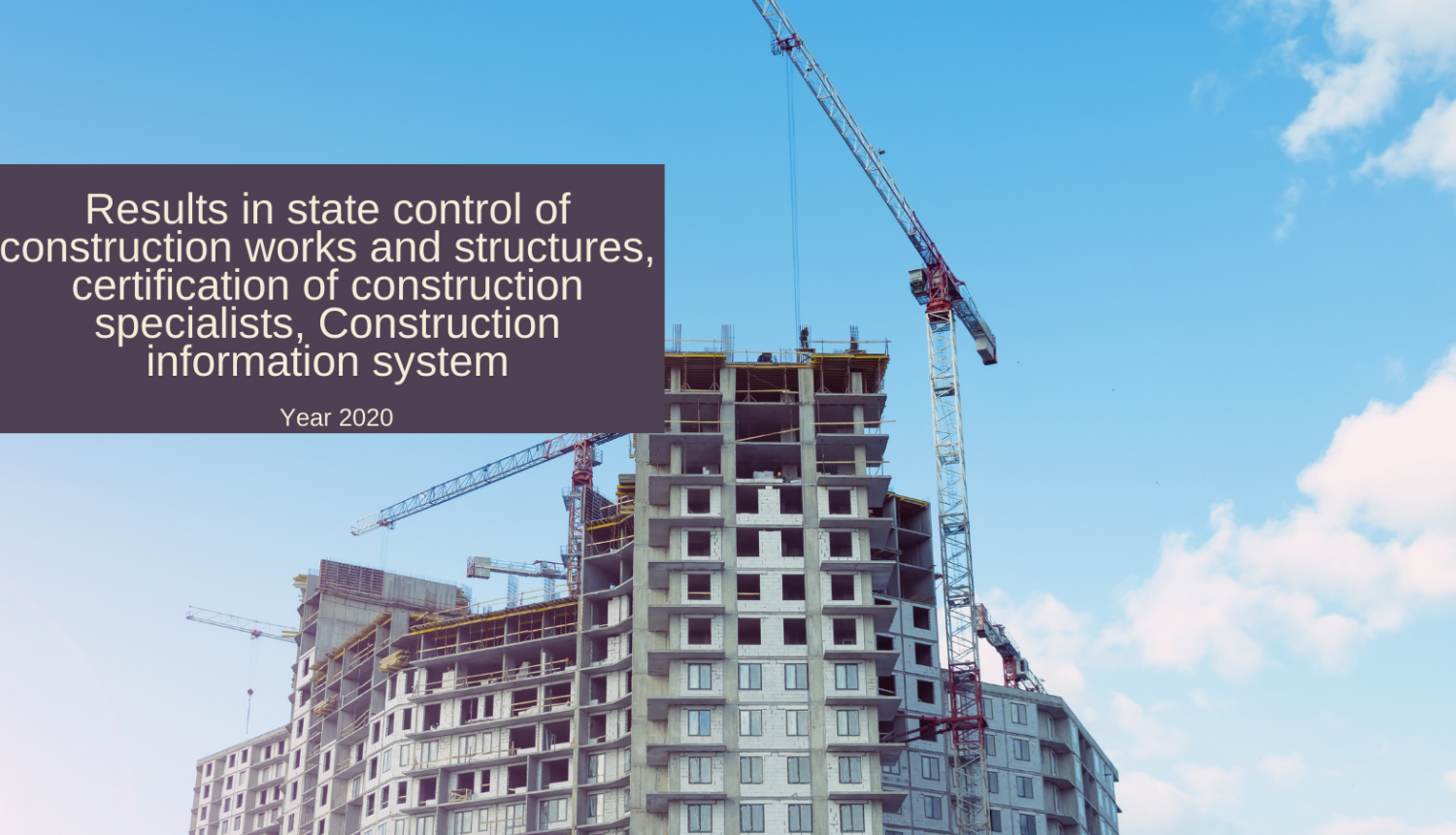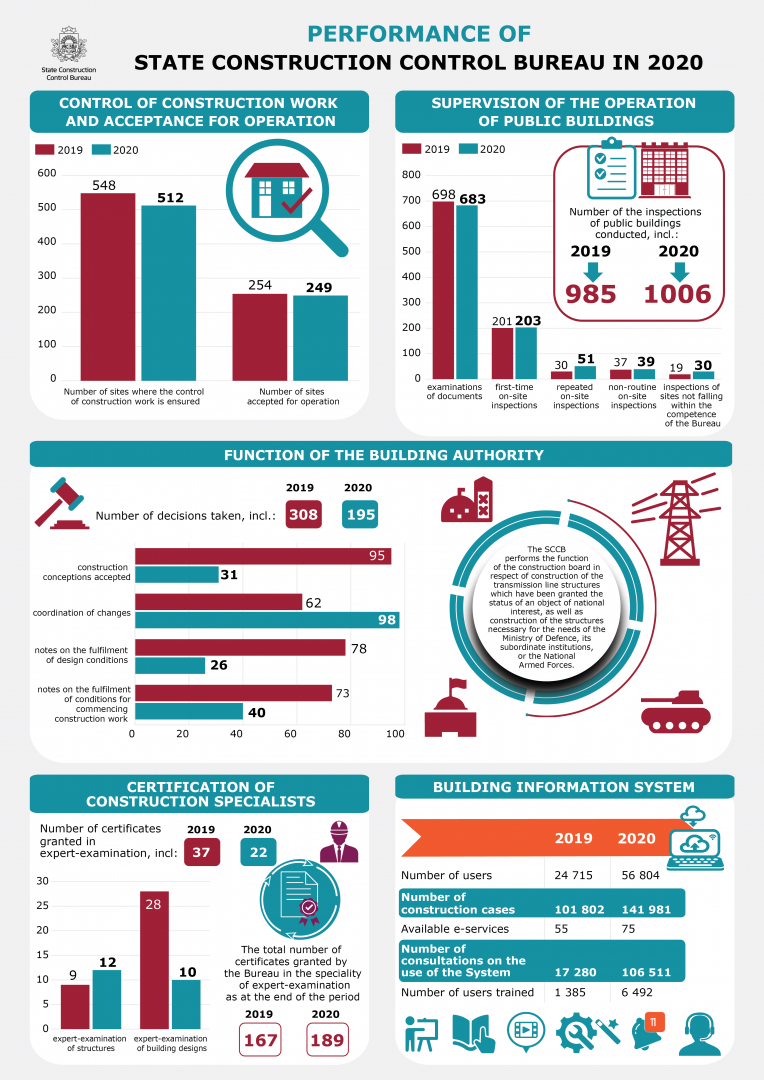A total of 5,846 owners of buildings which accounts for 74 % of all public buildings monitored by the State Construction Control Bureau (SCCB) were to carry out a periodic technical survey by 30 September 2019. Only 8 % have complied with this requirement by the end of 2020 submitting an opinion of technical survey (OTS).
In light of the monitoring activities carried out by the SCCB, according to the information currently available to the Bureau, 51 % of buildings were to undergo the technical survey by the end of September 2019. This, however, does not replace an obligation of the owners to carry out the periodic technical survey of a building by calling on a certified construction specialist according to the construction standard LBN 405-15 “Technical Survey of Structures”.
At the moment, the SCCB monitors around 8,000 public buildings of group III out of which opinions of technical survey have only be submitted with regard to 864 buildings. As to the buildings commissioned before 2004 which were to undergo the survey by the end of September 2019, only 448 opinions of technical survey have been submitted. The reasons for those low numbers are different – there are buildings for which an assessment of technical condition has only been carried out in respect of individual parts of the building, for example, prior to implementing a project for increasing energy efficiency of the building, yet a comprehensive evaluation of the compliance with the essential requirements, such as mechanical strength and stability, safety of operation, and fire safety, is missing. Part of the buildings has been in fact subject to the technical survey, but the opinions have not been entered into the Building Information System (BIS). As to other buildings, the opinions have been entered into the BIS, and they correspond to the requirements laid down for the performance of the periodic technical survey in terms of content, the types of opinions have, however, not been marked correctly.
In order to remind owners of buildings of their obligation to evaluate technical condition of the buildings, the SCCB sent them letters last year. They contained warnings about potentially holding owners administratively liable which has resulted in some improvement but not sufficient. “The current situation clearly demonstrates that the owners of buildings are not able to meet their duties. It is impossible to plan maintenance works of a building without assessing its technical condition. It should be repeated that it is not only a privilege to be an owner of the building but also a duty, therefore owners should carefully consider whether they can maintain this responsible status also in the future,” emphasises Svetlana Mjakuškina, Director of the SCCB.
Overall, in 2020, the SCCB has conducted 1,006 inspections within the framework of supervision of the service. Risks of operating buildings have been identified in 62 % of cases. It is often that handrails or warnings regarding height change are missing, glazed surfaces have not been marked, or there is a risk of falling façade elements.
With regard to the control of construction work, the deficiencies established last year are more or less the same as those identified in the previous years. In most cases the non-compliance has been related to changes in a building design which may affect mechanical strength and stability of the bearing constructions of a structure. Although the number of construction sites supervised by the SCCB has declined in 2020, in general a positive trend can be observed towards the quality of the construction process. For the purpose of stimulating it, the SCCB has developed guidelines for the quality control system of a performer of construction work. In order to increase the quality of construction expertise, guidelines for construction expertise have been developed in cooperation with the industry.
In order to promote safety of public buildings, the SCCB has changed over to systematic inspection of sites by focusing primarily on control of the structures with a higher level of risks. For this purpose, the work is underway to further improve the BIS, creating a “home file” or information storage for each surveyed structure and introducing a risk algorithm to assess its technical condition. The development of the BIS also continues in other directions, for example, expansion of the range of e-services, creating features for entering BIM projects into the BIS, introduction of the owner communication system, and development of the accounting process of construction waste.
The Single Database for Electronic Working Time Accounts (SDEWTA) has been integrated into the BIS since February 2020. Information regarding 234 main performers of construction work, 4,506 employers, 956 construction sites, and 43,088 employees has been registered in the SDEWTA as at the end of 2020. These are important data which enable not only the SCCB but also other authorities, such as the State Labour Inspectorate or the State Revenue Service, to perform their supervisory functions more efficiently.
One of the BIS sections used most often is registers – as a result of integrating the Register of Energy Auditors of Enterprises and the Register of Energy Reports of Enterprises into the System in 2020, the number of registers has now reached eight. The System has been used more intensively to update information – out of 4,972 submissions regarding inclusion of annual information in the Register of Construction Merchants 82.7 % of the submissions have been received electronically.
January has been a year since every new construction intention in Latvia can be registered only electronically in the BIS. As the amount of information in the system increases, the number of its users grows rapidly as well. At the end of 2020, the BIS had 56,804 users (an increase of ~ 130% during the year). By 31 December 2020, the number of construction cases in the BIS reached 141,981, showing an increase of ~ 39%.
The number of electronic services in the BIS has also grown rapidly - the number of completed construction e-services in 2020 was 285,895, which is 99% of the number of initiated e-services. This shows that the services available in the system are understandable and user friendly. The most popular construction e-service on the portal is issued powers of attorney, which make up one third or 35%. The second most popular is the harmonization of construction design documentation (17%), but the third most popular is the request for technical regulations (13%). "The development of the BIS can clearly be considered as one of the positive examples of project implementation and management in public administration, which has provided significant support to the public and the construction industry during this period," points out Svetlana Mjakuškina.
Overall, the SCCB has reached important aims in 2020 – at the end of 2020, the quality management system integrated by the Bureau has been certified according to the requirements of ISO 9001:2015. The Bureau has been recognised as a leader in the “Consult First” initiative in the category “Leader in Information and Consulting 2020”, and has occupied the second place in the overall evaluation of the “Consult First” initiative. In demonstrating its orientation towards clients’ needs, in November, the SCCB joined the single website platform of the State administration, thus ensuring that the content posted on the website is also accessible to people with a visual, hearing, motor or perceptual disability.




